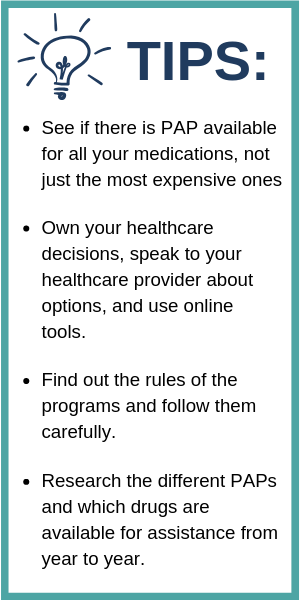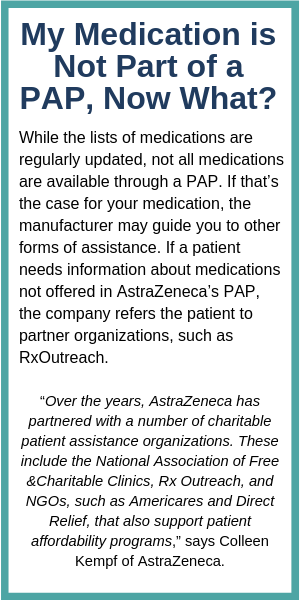Patient Assistance Programs: A Guide for Patients
Cancer is costly. Each year, it costs $180 billion in health care expenses and loss of productivity, says the American Cancer Society. For individuals, it is the life-saving medications they need that can cost the most. According to cancer.gov, 90 percent of Americans say that cancer drugs are too expensive, and the prices have been steadily increasing for the last twenty years. Some cancer drugs debut on the market at a cost of more than $100,000 per patient per year, some for as much as $400,000. With this type of pricing, even insured patients can be facing out-of-pocket expenses in the tens of thousands.
When patients can’t afford their medications, it can lead to people taking them in lower doses or skipping them altogether, and that can lead to serious consequences, such as shortened survival times. High-cost medications can also lead to financial ruin for some patients. Chronic lymphocytic leukemia (CLL) patient James Miller, whose copay for his experimental and life-saving medication is “outrageously expensive” at $790 a month, says that, medications could eventually bankrupt people, especially if the medications are a patient’s only option for survival.
It’s literally a matter of life or death for patients like Miller to find funding solutions for their cancer drugs. Luckily for him, his medication is covered through the manufacturer’s Patient Assistance Program. Drug manufactures created Patient Assistant Programs, commonly known as PAPs, to provide qualifying patients with free or discounted medications.
While just about every manufacturer has an assistance program, one of the first manufacturers to offer a PAP was AstraZeneca. Company representative Colleen Kempf says, AstraZeneca began offering patient assistance over 40 years ago. The program now covers the company’s marketed medicines, and Kempf says, in the past ten years, the company has helped over 4 million patients with access to medications. “Our programs are driven by our corporate value in putting patients first. We believe that we have a role to play to support patients, and since 2005 have expressed this commitment in a very public way through our advertising.” Their PAP slogan, “If you can’t afford your medications, AstraZeneca may be able to help,” might be familiar to many as it is frequently heard at the end of its television adds and leads patients to its website which is where most PAP information can be found.
Find a PAP
The most important thing to know about PAPs is that they are available. They all vary a bit and have different names, but chances are, your drug’s manufacturer has one. AstraZeneca’s is called AZ&ME. Genentech, the manufacturer of the medication Miller takes for his CLL, calls its program Genentech Access. Celgene refers to its as Patient Support, and Takeda refers to its as Help at Hand.
Once you know assistance is available, it’s fairly easy to find it. All it takes is an online search of the name of the drug, coupled with the words “patient assistance program”, and you should be well on your way to the application process.
John Rosenguard, a multiple myeloma patient, learned about PAPs while doing research about insurance carriers. In addition, Celgene, the manufacturer of his medication, led him to its assistance program through an online risk management survey he was required to take when he was prescribed the medication.
NeedyMeds
There are also websites specifically designed to help patients find assistance. Non-profit website needymeds.org was formed in 1997 with the intent of helping patients navigate PAPs.
While it may seem like the best place to learn about PAPs is the internet, patients and drug companies both recommend you include talking to your healthcare provider about options. Miller learned about the Genentech PAP he uses through his doctor who put him in touch with a specialty pharmacy who provided him with a PAP application. Miller says he would not have known about the PAP on his own, but that without it he would “go broke”. He advises other patients to ask their treating physicians about options. “Any doctor prescribing an experimental drug like that will have a relationship with a specialty pharmacy,” he says.
Miller’s advice is good, but most people don’t seem to be following it, according to cancer.gov, which reports that only 27 percent of cancer patients, and less than half of oncologists, say that they have had cost-related discussions. But, nearly 66 percent of the patients say they want to talk to their doctors about costs. They should.
AstraZeneca’s Kempf says the company ensures that healthcare providers, patients, and patient groups are made aware of its AZ&ME assistance program. “As with any type of information or program, providers will have different levels of understanding regarding available PAP programs,” says Kempf. “The AZ&ME program works closely with healthcare provider offices on applications at their request and we’ve also seen some offices support their patients by assisting with the enrollment process for their patients.”
PAP Enrollment
 Each company has a different process for enrolling in its PAP. Some applications require extensive financial information, while others require basic information; Some require doctors to fill out a portion of the application, while others only need a signed prescription. Miller says for the Genentech enrollment process, he had to provide his financial information and that the application had two or three pages for his doctor to fill out. Rosenguard says the Celgene application process was extremely simple and that it took about two weeks for him to be accepted into the program.
Each company has a different process for enrolling in its PAP. Some applications require extensive financial information, while others require basic information; Some require doctors to fill out a portion of the application, while others only need a signed prescription. Miller says for the Genentech enrollment process, he had to provide his financial information and that the application had two or three pages for his doctor to fill out. Rosenguard says the Celgene application process was extremely simple and that it took about two weeks for him to be accepted into the program.
The best way to know what the enrollment process is for the manufacturer of your medication is to go to the company website. The websites are easy and straightforward for patients to navigate. For example, the Celgene Patient Support site has large buttons that say “Enroll now” and “Financial Help”. The words are in big, bold type, and each step is written in clear language. The site also provides a phone number, email, and fax information. There is an option to download the application form if you prefer to print it and fill it out by hand. The steps you will take are listed clearly, and what you need to include with the application is listed clearly. The process was easy and efficient, says Rosenguard.
Most applicants shouldn’t require any assistance beyond what the manufacturers can provide on their websites or by phone, but there are some businesses who will help patients complete the enrollment process for a fee. The prices vary, as does the quality of service.
PAP Qualification
Not all patients will qualify for assistance. While each program has its own qualifying criteria, and there may be different requirements for different medications produced by the same manufacturer, in general, to qualify for a PAP, a patient must:
- Have very limited or no drug coverage from public or private sources
- Must demonstrate a financial need based on a set income and assets
- Provide proof of US residence or citizenship.
“The AZ&ME program is intended to serve patients most in need and has income eligibility criteria that speak to this design,” says Kempf. “The program primarily serves patients that have no insurance coverage or patients that face affordability challenges with their Medicare cost-sharing requirements.”
In addition, the amount of assistance a patient receives and the length of time each patient can stay on the program varies. AZ&ME patients without insurance are required to reenroll in the program annually, and Medicare patients are required to reenroll at the start of each calendar year.
“It is important for patients to understand the eligibility requirements as well as the documentation requirements that are typically associated with applications,” says Kempf. “Ensuring that the application is filled out, complete, and submitted with the required documents, helps ensure an easy enrollment process.”
 PAP Basics
PAP Basics
Once accepted into the program, both Miller and Rosenguard say that there is not much of a time commitment from them. They both receive their medication through a specialty pharmacy. Miller says his is delivered to his door each month, and Rosenguard says he is able to refill his prescription online, and also has a monthly follow up phone call with the pharmacy. In addition, Rosenguard is required to follow risk management guidelines to participate in the Celgene PAP. Guidelines, as specified by Celgene include, following safe sex practices, not donating blood, and monitoring cuts with blood loss.
AstraZeneca also uses a central pharmacy to dispense its medications to patients, says Kempf. “All medications are dispensed by a pharmacy and are sent directly to the patient’s home unless it is a medication that requires in-office administration by the physician. In office administration products are sent directly to the healthcare practitioner,” she says.
Are PAPs Worth It?
For patients struggling to pay for their medications PAPs may be the only option, and the pharmaceutical companies seem committed to providing the service. Kempf says that at AstraZeneca, they are always evaluating patient feedback to see how they can better serve patients, including streamlining the application process.
Rosenguard recommends the PAP programs. He says, co-pays, like his that were $200 a month per medication, can add up quickly. “The benefits were noticeable and met my needs to control costs over the long term,” says Rosenguard. “Plus, it educated me to help others (employees, support group members, friends) who might need this information in the future.”




 Each company has a different process for enrolling in its PAP. Some applications require extensive financial information, while others require basic information; Some require doctors to fill out a portion of the application, while others only need a signed prescription. Miller says for the Genentech enrollment process, he had to provide his financial information and that the application had two or three pages for his doctor to fill out. Rosenguard says the Celgene application process was extremely simple and that it took about two weeks for him to be accepted into the program.
Each company has a different process for enrolling in its PAP. Some applications require extensive financial information, while others require basic information; Some require doctors to fill out a portion of the application, while others only need a signed prescription. Miller says for the Genentech enrollment process, he had to provide his financial information and that the application had two or three pages for his doctor to fill out. Rosenguard says the Celgene application process was extremely simple and that it took about two weeks for him to be accepted into the program. PAP Basics
PAP Basics

